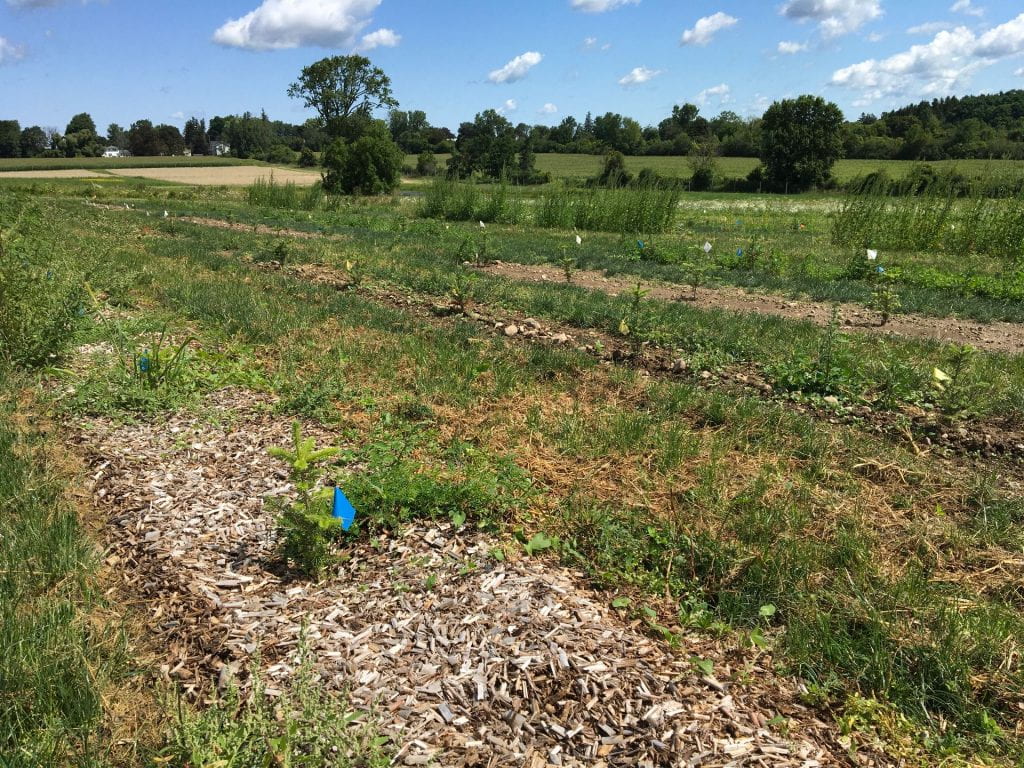
Back in June we introduced you to a new project comparing different methods for weed and root disease management when establishing Christmas tree seedlings. Recall that this is a collaboration among Bryan Brown, Amara Dunn, Brian Eshenaur, Betsy Lamb, and Lynn Sosnoskie. We wrapped up our first season in October, and we have a first look at some of the data. In this post, we’ll focus on tree survival and tree growth. There’s a lot more weed data!
Treatments
Let’s start with a quick reminder of the treatments we were comparing. Each row of 28 trees received the same weed management treatment. Each row was also divided into four plots of seven trees each. Each plot within a row received a different root treatment. Here’s a map of how the treatments were laid out in the field.
Weed management (in-row, within a 30” band around the row of trees; between row zones were seeded with grass and mowed 4 times) :
- Cultivate – three times early in the season using a tractor drawn KULT Kress Argus Toolbar with sweeps, finger weeders, and a rear side-shift adjustment
- Herbicide – conventional active ingredients (oxyfluorfen and pendimethalin applied shortly after planting, with a fall application of glyphosate) as a control treatment
- Mow – mow about every two weeks with a walk-behind mower
- Mulch – 3 inches of chipped shrub willow mulch
- Untreated – No weed management at all
Root disease management:
- ProPhyt (active ingredient: potassium phosphite) – a biopesticide applied by dipping bare roots of seedlings just before planting; mixed 1.28 fl oz in 2 gallons of water for 140 trees (11 fl oz/A if you plant 1,200 trees/A)
- RootShield PLUS WP (active ingredient: Trichoderma harzianum Rifai strain T-22 and Trichoderma virens strain G-41) – a biopesticide applied twice (the day after planting and 7 weeks later) as a drench around each tree (24 oz/A in 171 gallons of water/A)
- Subdue Maxx – a conventional fungicide applied twice (the day after planting and 5 months later) as a soil-directed spray (2.5 pt/A in 140 gal/A in a 6-inch band on either side of the row of trees). We made the application with a hand-pump backpack sprayer fitted with a TeeJet TTI11005 nozzle with a shield rotated parallel to the row of trees. The maximum pressure possible with this sprayer is 60 psi. After application, we applied an extra 0.45 gallon of water per plot of 7 trees with the same sprayer (280 gal/A additional water).
- Water – 1 pt of water poured around each tree at planting, as a control.
What we measured
We’re interested in how the weed and root disease treatments impact survival, growth, and quality of these trees. Thanks to our excellent technicians, Marcus and Erik, for helping us measure all of these trees! Betsy and Amara were helping, too, but in this picture Amara is behind the camera.
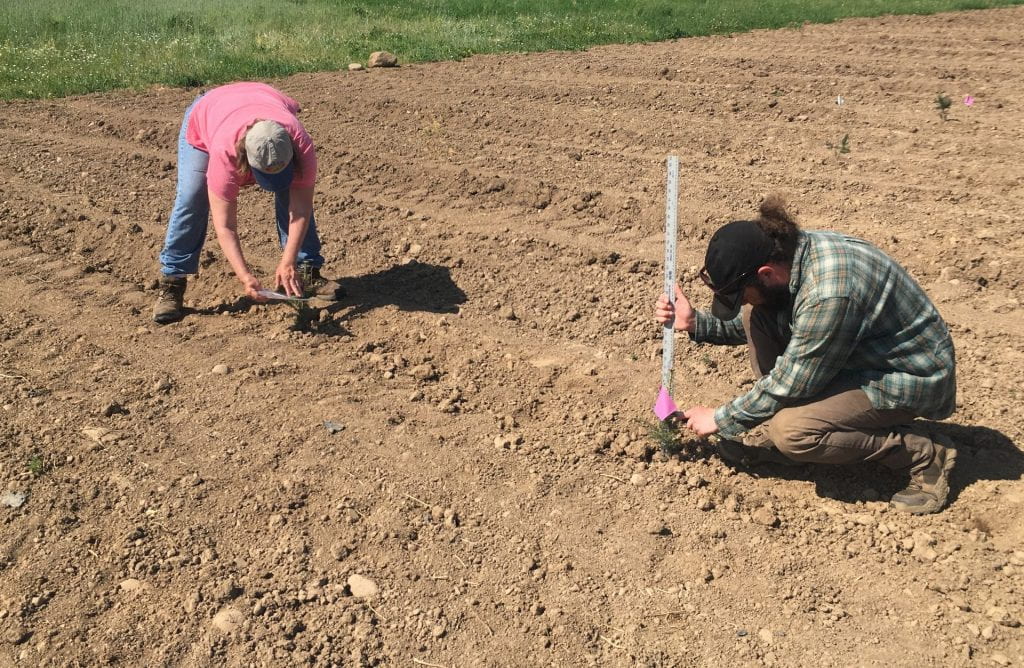
On May 25 (about a week after planting) and again on October 6 we measured the height of each tree (from the soil to the tallest part of the tree, even if it wasn’t the leader anymore) and the diameter of the tree trunk 4 inches above the soil. In both May and October, we also rated the color of the needles using this scale. However, we only used: 2 (darkest green), 5 (medium green), 7 (paler green), and 9 (yellow or brown).
Of course, measuring and rating each tree also allowed us to take note of which trees had died (versus a few that unfortunately succumbed to “mower blight”).
What we found
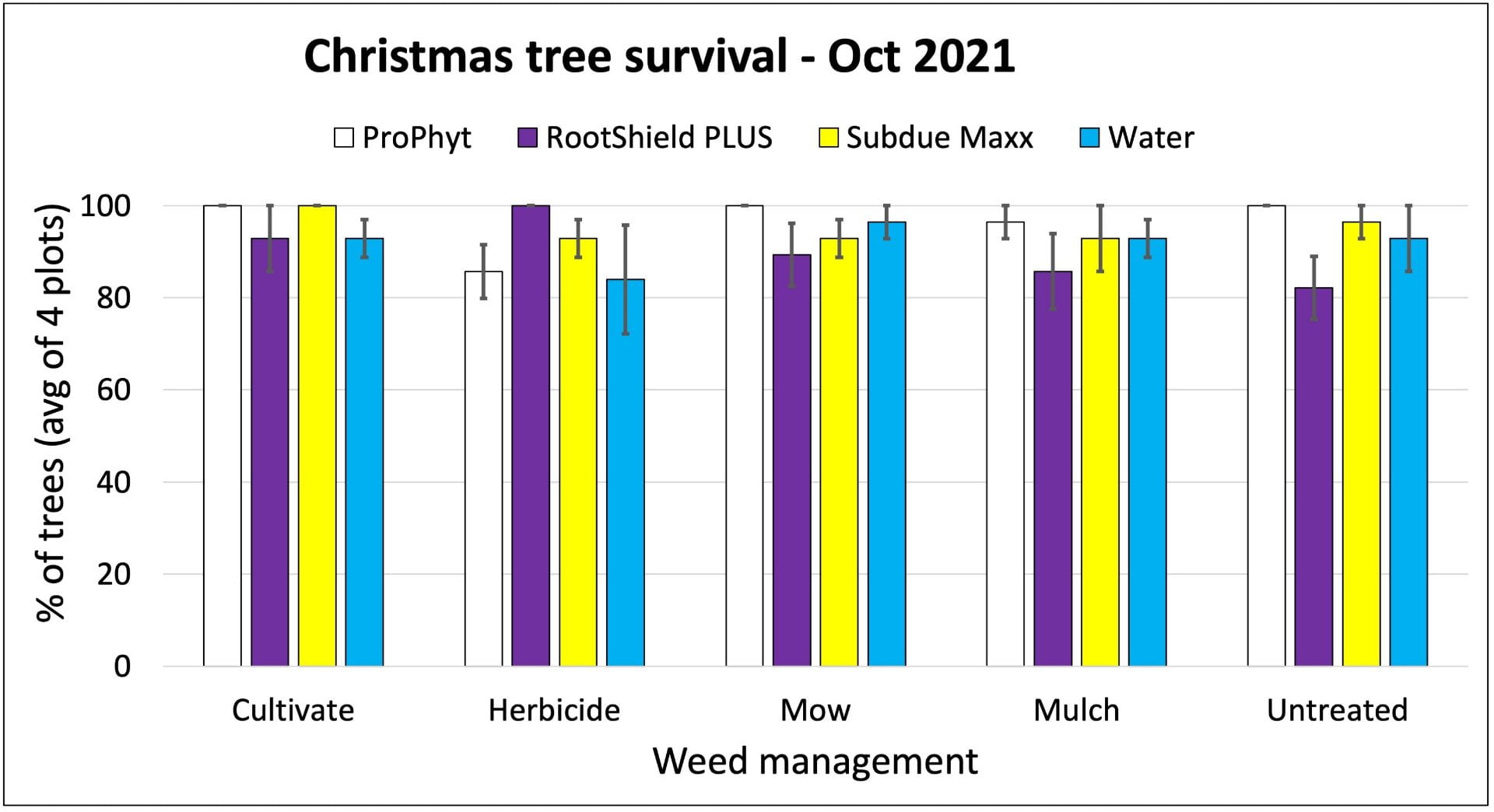
It’s too early to know for sure, but it’s possible that the root treatment that results in the best seedling survival might depend on which weed management strategy you use. For example, after just one year, the RootShield PLUS-treated trees did better than the ProPhyt-treated trees where herbicide was used, but not where the weeds were allowed to grow unchecked (‘Untreated’). We haven’t done a statistical analysis on the data, yet, but the little lines at the top of each bar are an indication of the amount of variability amongst the four plots in each treatment (one standard error above and below the mean percent survival, for those who might be interested).
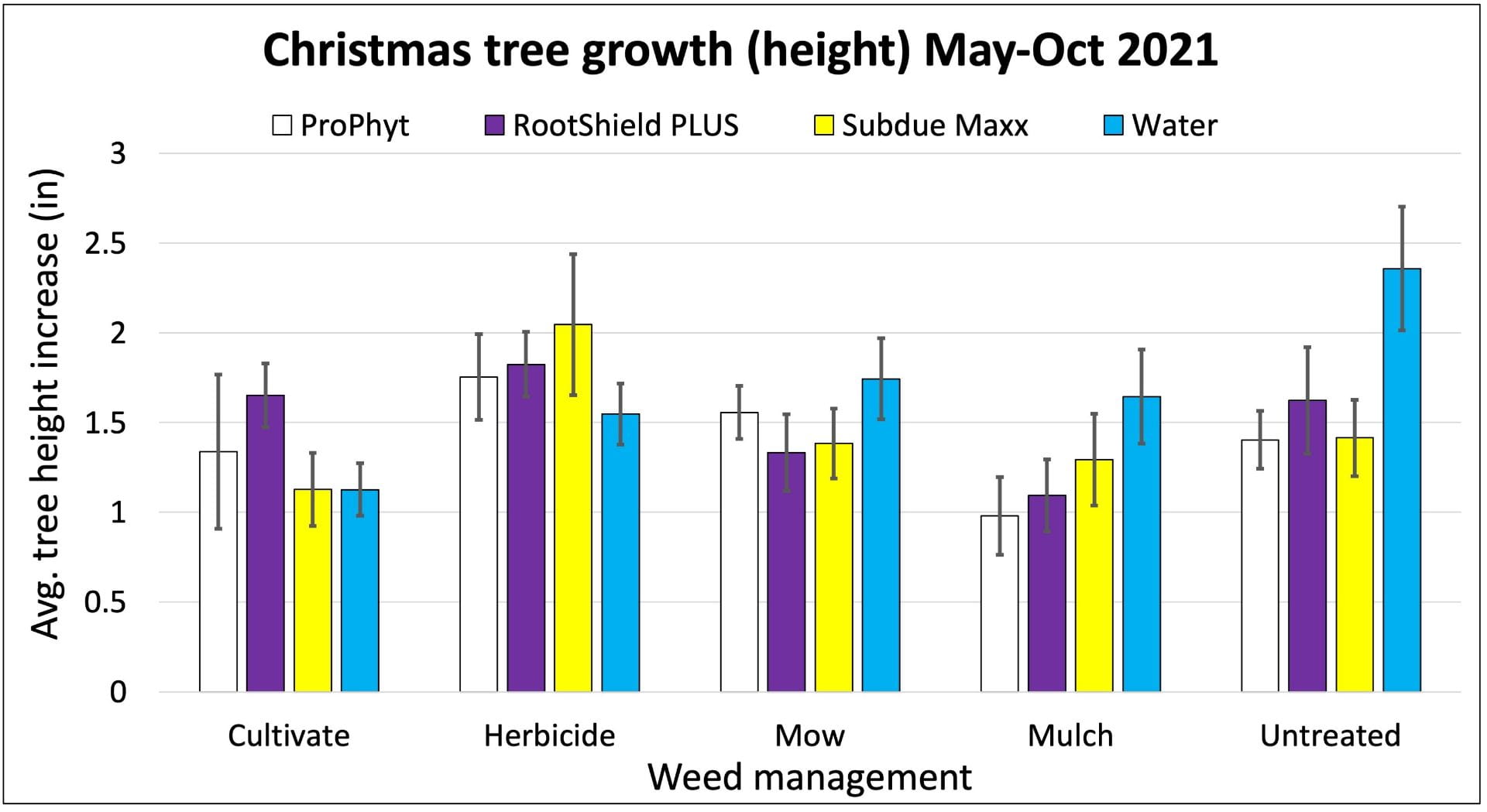
These Fraser fir seedlings grew between 1 and 2.5 inches during their first season. Much like the tree survival, the root treatment that produced the most growth wasn’t consistent across all weed management strategies. Results for tree trunk diameter were similar.
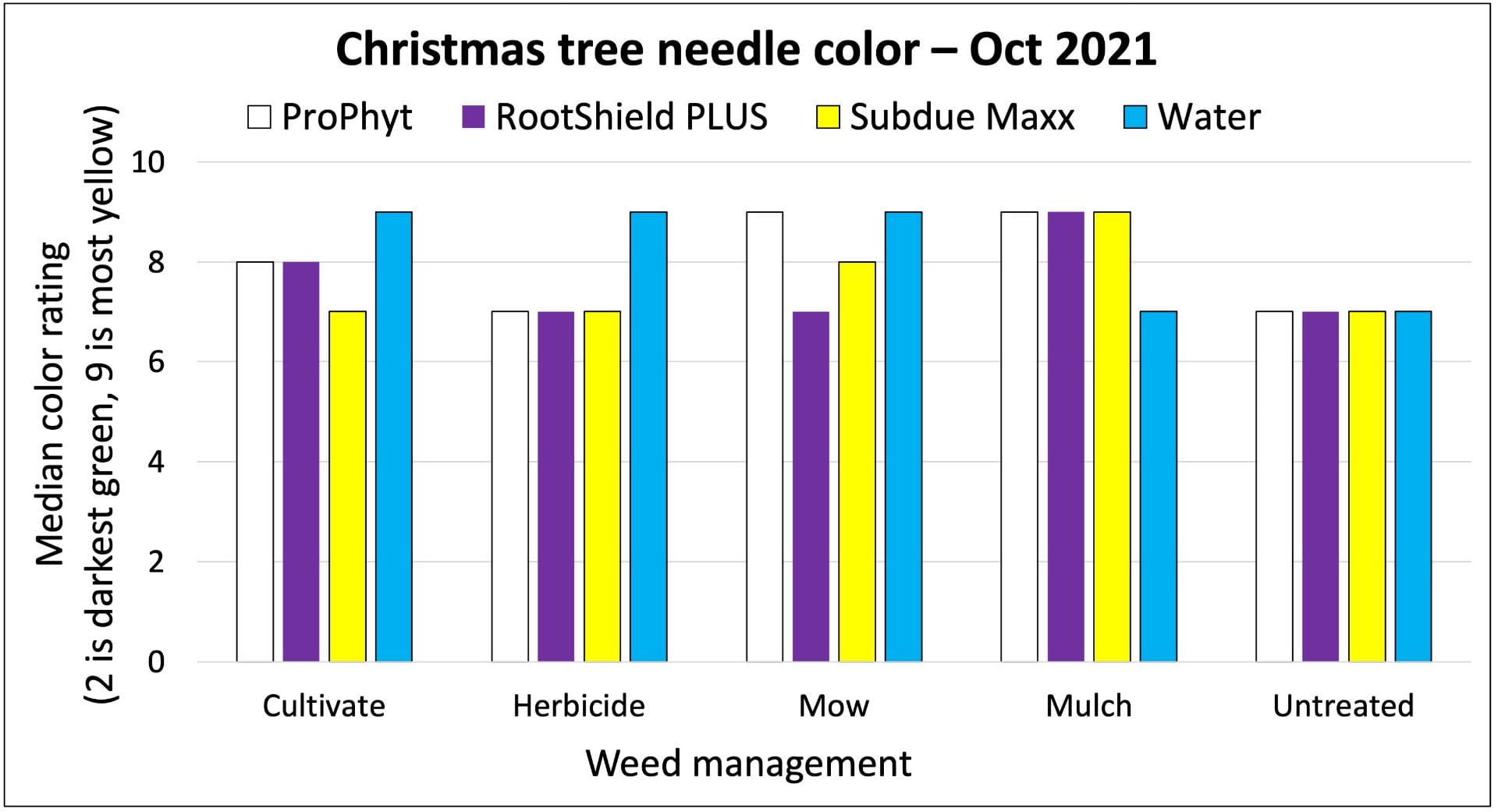
Recall that needle color was rated as 2 (darkest green), 5, 7, or 9 (most yellow or brown). So on this graph, shorter bars indicate better needle color. Also, this rating scale impacted how we summarized the data. Instead of taking the mean needle rating, we used the median. (Here’s a quick refresher on the difference.) And the graph doesn’t have those little lines to summarize the variability in each treatment. Too early to draw firm conclusions, but again, there might be some interactions between root treatment and weed management strategy.
What does it cost?
Economic risk is one of the risks we seek to reduce through IPM, so we’ve been keeping track of the costs associated with our pest management strategies. Based on the way we applied the root treatments and some local price estimates, here’s what we would have spent per acre for these treatments, assuming we planted 1,200 trees on each acre (that’s 6 ft x 6 ft spacing).
| Fungicide | Rate/A | Number of applications | Cost/A (Supplies) | Cost/A (Labor1) |
| ProPhyt | 11 fl oz2 | 1 | $4 | $1,037 |
| RootShield PLUS WP | 24 oz3 | 2 | $123 | $4,150 |
| Subdue Maxx | 2.5 pt3 | 2 | $82 | $2,074 |
| Water | – | 1 | $0 | $2,075 |
1We assumed a labor rate of $20/hr. These costs were calculated based on the time it took us to apply the products. This includes drenching each tree by hand (RootShield PLUS WP and water) and applying Subdue Maxx (and additional water to move it into the soil) with a backpack sprayer. On a larger scale, there’s surely a more efficient way to do this.
2Seedling roots were dipped in a ProPhyt solution prior to planting. The rate on the label is 4 pt/100 gallons of water. We mixed up 2 gallons of root dip solution (containing 1.28 fl oz of ProPhyt) to treat 140 trees. If we had used a fresh 2 gallons for every set of 140 trees, we would have used 11 fl oz of ProPhyt on an acre of 1,200 trees.
3Because RootShield PLUS WP was applied as a drench to each tree and Subdue Maxx was applied as a soil-directed spray banded on either side of the row, these rates are per acre of ground to which pesticide was applied. This is less than the total space taken up by these trees in the field. Read and follow the pesticide label for instructions on calculating quantity of product needed for banded applications.
And here’s a summary of our weed management costs. You can see all the details of these costs (including labor and supplies) here.
| In-row weed management | Cost/A (labor and supplies) |
| Cultivate | $248 |
| Herbicide | $86 |
| Mulch | $1,153* |
| Mow | $293 |
| Untreated | $0 |
*Assumes woodchips can be obtained locally at no cost
Take home
With only one season of data, it’s too early to draw conclusions about the effectiveness (or cost effectiveness) of each treatment. So far, survival of trees treated with ProPhyt is looking very good across most weed management strategies. And we’re seeing some indication that the best (in terms of tree survival, growth, or color) root treatment to use may vary depending on what you’re doing to manage weeds.
In late October we also dug up five dead trees and sent them to the Cornell Diagnostic lab to check for Phytophthora. The trees had been dead for a while, so they were only able to test for the presence of any Phytophthora species (which could include some that don’t cause disease on Christmas trees). Four out of five trees came back positive, which makes us feel more confident that we picked a good field for this trial…if by “good” you mean one where trees will be exposed to Phytophthora. For the purposes of this project, that’s exactly what we mean.
Please let us know if you have questions and stay tuned for more updates on this project. We’ve got at least two more years to go! You can check back on this blog (subscribe so you’ll know when new posts are available!), follow Lynn Sosnoskie and Amara Dunn on Twitter or on Instagram (@specialtycropweedscience and @biocontrol.nysipm), or check out Bryan Brown’s webpage. We’ll also be hosting another field event in 2022 and hope to provide updates at future Christmas Tree Farmers Association of NY meetings.
This work is supported by Agriculture and Food Research Initiative – Foundational and Applied Science Grant no. 2021-68008-34179/project accession no. 1025660 from the USDA National Institute of Food and Agriculture.
This post was written by Amara Dunn, Biocontrol Specialist with the NYSIPM program, with helpful input from project collaborators. All images are hers, unless otherwise noted.

